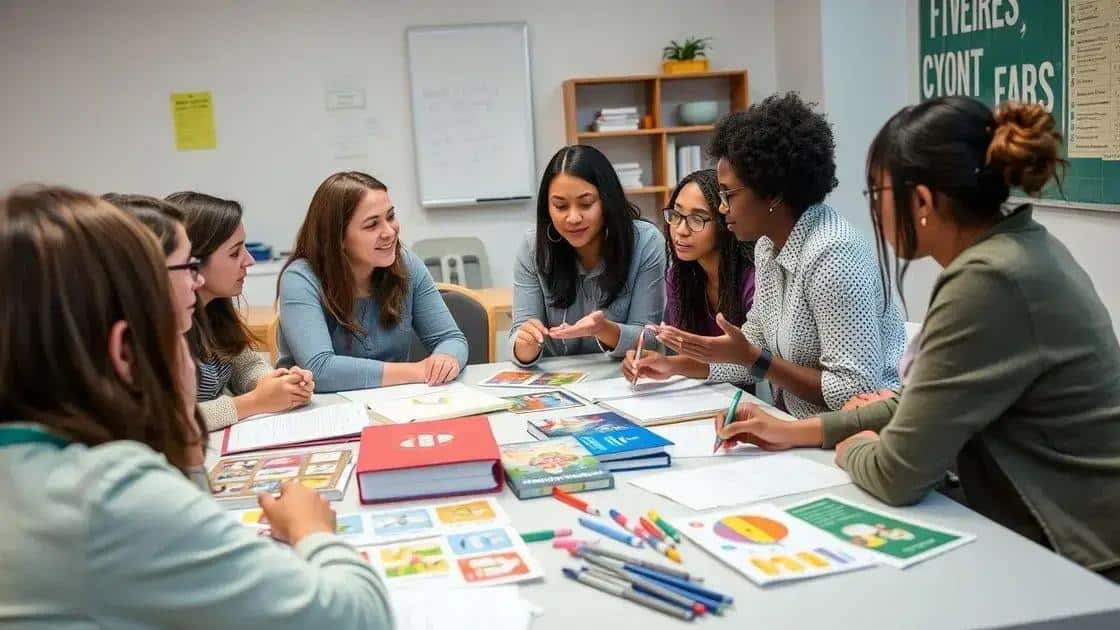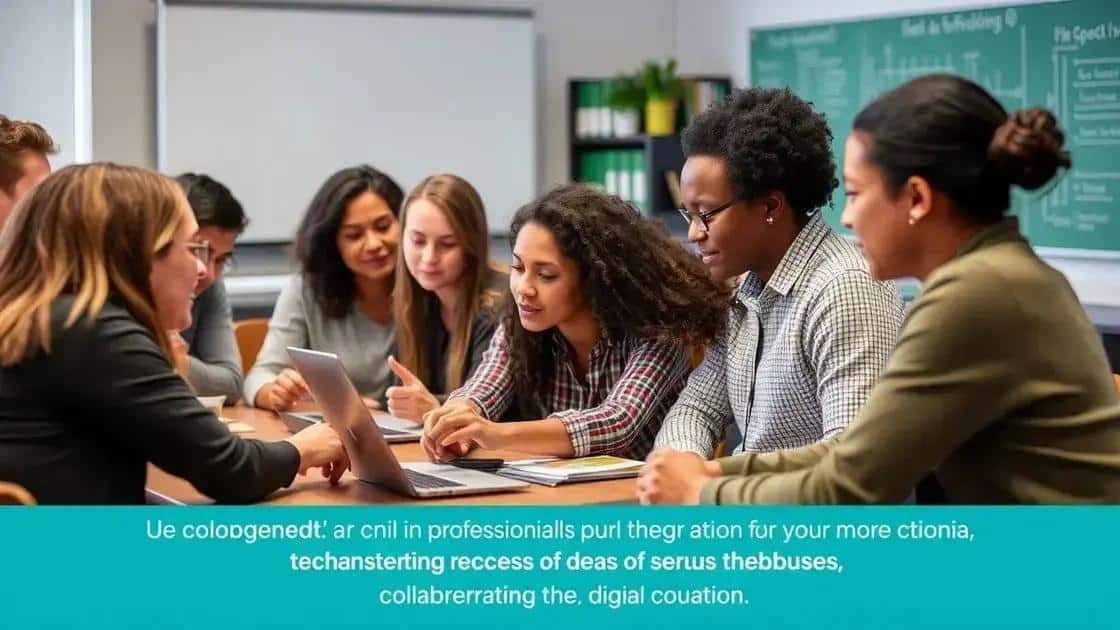Teacher professional development: unlocking teaching potential

Anúncios
Teacher professional development enhances educators’ skills and teaching effectiveness, but it faces challenges such as time constraints, limited resources, and resistance to change, which must be addressed for meaningful impact.
Teacher professional development plays a vital role in helping educators enhance their skills and adapt to changing educational landscapes. Have you ever wondered how ongoing training can transform not just teaching but also student engagement in the classroom? Let’s explore the possibilities.
Anúncios
Understanding the importance of teacher professional development
Understanding the significance of teacher professional development is essential in creating an effective learning environment. As education evolves, so must the skills of educators. This continuous growth opens doors to innovative teaching methods and better student engagement.
Benefits of Teacher Professional Development
Engaging in professional development allows educators to stay current with new trends and practices. Research indicates that well-structured training can lead to:
- Improved teaching strategies
- Increased student achievement
- Enhanced collaboration among teachers
- Greater professional satisfaction
Moreover, participating in these programs fosters a culture of lifelong learning. Teachers can share experiences and strategies, enhancing their effectiveness in the classroom.
Anúncios
Types of Professional Development
There are various forms that teacher professional development can take, including:
- Workshops and seminars
- Online courses
- Cohort groups for collaborative learning
Each of these options offers unique benefits, accommodating different learning styles and schedules. Teachers should consider what aligns best with their professional goals.
Furthermore, evaluating the impact of these programs is crucial. Understanding how professional development translates into improved classroom performance helps educators justify investments in their own learning. This ongoing evaluation ensures that development is not only relevant but effective.
Ultimately, valuing teacher professional development cultivates a thriving educational environment, where both teachers and students can succeed. When teachers engage in lifelong learning, the entire school community benefits from enriched experiences.
Effective models for professional development

Effective models for professional development provide educators with the tools and resources necessary to enhance their teaching practices. By understanding these models, schools can create an environment that supports continuous improvement and student success.
Collaborative Learning Communities
One of the most impactful models is collaborative learning communities. This approach encourages teachers to work together, sharing strategies and outcomes. In these groups, educators can:
- Exchange ideas and insights
- Participate in peer observations
- Engage in reflective discussions
Collaboration not only strengthens teaching but builds a sense of community among educators. When teachers support each other, they foster a positive school culture.
Workshops and Training Sessions
Workshops and training sessions are traditional but effective models of professional development. These events are often structured to focus on specific skills or content areas. Educators can benefit from:
- Hands-on activities to practice new skills
- Expert-led sessions that provide deep insights
- Networking opportunities with other professionals
Though valuable, these sessions should be tailored to meet the unique needs of the teachers involved.
Another effective model involves online platforms that provide flexibility and accessibility. With digital tools, educators can learn at their own pace, revisiting materials as needed. This model supports diverse learning preferences and can reach more teachers in different locations.
Finally, mentorship programs can be transformative. Pairing experienced educators with newer teachers fosters personal growth and skill-building. Mentors provide guidance, share best practices, and help mentees navigate challenges in the classroom. This relationship is crucial for creating a supportive learning environment.
How to measure the impact of professional development
Measuring the impact of professional development is crucial for understanding its effectiveness. Educators need to see how their investment in these programs translates into better teaching and improved student outcomes. By utilizing various assessment methods, schools can gain valuable insights.
Setting Clear Goals
Before a professional development program begins, establishing clear goals is essential. When educators know what they aim to achieve, tracking progress becomes easier. Goals should be:
- Specific and measurable
- Aligned with school objectives
- Realistic and time-bound
This targeted approach allows for a focused evaluation of success and areas needing improvement.
Pre- and Post-Program Assessments
Implementing pre- and post-program assessments can provide critical data on changes in teacher practices and student learning. Questions and activities used in these assessments can reveal knowledge gains and shifts in teaching methods. The use of surveys can also gauge teacher confidence and attitude before and after the training.
Another effective method is gathering feedback directly from students. Student performance data and engagement levels can offer a wealth of information. When teachers see the direct results of their learning in student progress, it highlights the effectiveness of the professional development they received.
Furthermore, ongoing observations in classrooms are invaluable. Collecting qualitative data through classroom visits allows administrators to assess whether teachers apply what they learned. This approach also promotes constructive feedback that teachers can use to refine their practices.
All these methods combined create a comprehensive picture of how professional development impacts teaching and learning. Ultimately, it enables schools to determine the best practices and resources for continued growth.
Challenges faced in teacher professional development initiatives

Challenges faced in teacher professional development initiatives can hinder the effectiveness of these programs. Understanding these hurdles is essential for creating successful training experiences for educators. From logistical issues to emotional barriers, various factors can impact participation and outcomes.
Lack of Time
One significant challenge is the lack of time teachers have to engage in professional development. Many teachers juggle classroom responsibilities, grading, and planning, leaving little room for additional training sessions. When opportunities are limited, participation rates drop, and the benefits of professional development are diminished.
Limited Resources
Another barrier is the availability of resources. Many schools do not allocate adequate funding for teacher professional development. Without sufficient financial support, the quality of training programs may suffer. Schools may struggle to access high-quality materials or expert presenters, impacting the overall value of the training.
Additionally, teachers may feel overwhelmed by the sheer volume of training options available. Sorting through numerous programs and selecting the ones that align with their needs can be daunting. This confusion can lead to frustration, contributing to the reluctance to participate in such initiatives.
Resistance to Change
Some educators may exhibit resistance to change, especially if they are accustomed to their existing teaching methods. When teachers feel uncertain about new strategies or tools, they may hesitate to embrace professional development. Building a culture that supports innovation and risk-taking is vital to overcoming this challenge.
Finally, there may be insufficient follow-up or support after training sessions. Without ongoing guidance, teachers may struggle to implement what they have learned. Continuous support, coaching, and opportunities for collaboration are crucial for ensuring lasting impact.
FAQ – Frequently Asked Questions about Teacher Professional Development
What are the main challenges in teacher professional development initiatives?
The main challenges include lack of time, limited resources, resistance to change, and insufficient follow-up support.
How can we measure the impact of professional development on teachers?
Measuring impact can be done through pre- and post-assessments, ongoing classroom observations, and gathering feedback from both teachers and students.
Why is collaboration important in professional development?
Collaboration fosters a sense of community among teachers, enabling them to share strategies and support each other, which leads to better teaching practices.
What types of professional development models are most effective?
Effective models include collaborative learning communities, workshops, online courses, and mentorship programs, each catering to different learning styles.






